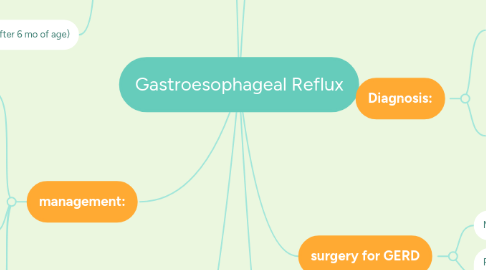
1. RED FLAGS:
1.1. bilious emesis
1.2. Forceful emesis
1.3. GI bleeding
1.4. Constipation/diarrhea
1.5. FTT/weight loss
1.6. signs of illness
1.7. Recurrent resp. illness/aspiration
1.8. abnormal exam
1.8.1. neurological abnormalities, bulging fontanelle, seizures
1.8.2. abdominal mass, distension, tenderness, ascites, HSM
1.8.3. syndromic findings
1.9. Later onset(after 6 mo of age)
2. management:
2.1. Uncomplicated GER
2.1.1. education of families
2.1.2. Breastfeed if possible, avoid overfeeding
2.1.3. avoid tobacco exposure
2.1.4. evaluation by Peds GI in not resolved by 18-24months
2.2. symptomatic GERD
2.2.1. thicken feeds (1TBSP oat cereal/ounce
2.2.2. GER positioning after feeds
2.2.3. consider hypoallergenic formula or "Similac spit-up"
2.3. most infants will NOT require medical treatment
2.4. symptoms begin to improve around 6 months of age
3. Meds for GERD
3.1. H2 antagonists (Zantac, Pepcid)
3.1.1. most likely reimbursed by medicaid
3.1.2. Liquid Zantac RECALLED
3.1.3. associated w/ increased risk of pneumonia & c. difficile
3.1.4. pain decreases, spit up continues
3.1.5. short term use preferred
3.2. PPI
3.2.1. Omeprazole(most evidence in kids)
3.2.2. reflux continues but not as uncomfortable
3.2.3. short term use preferred
3.3. Prokinetics
3.3.1. metoclopramide,erythromycin
3.3.2. do decrease reflux but have more SE, rarely used.
4. clinical features:
4.1. spit-up/reflux universal in young babies (30x/day!)
4.1.1. relaxation of LES after meals
4.1.2. supine position
4.1.3. liquid meals
4.2. Non-forceful regurgitation
4.3. GE reflux vs GERD:
4.4. GERD is when the reflux causes problematic symptoms
4.4.1. Esophagitis
4.4.2. Failure to thrive
4.4.3. Respiratory complications(special needs pts.)
5. Diagnosis:
5.1. Uncomplicated GER dx based on reassuring Hx & (normal) exam
5.1.1. "happy spitters"
5.1.2. No studies or labs required
5.2. If diagnosis unclear
5.2.1. UGI
5.2.1.1. not diagnostic for GER
5.2.1.2. Can r/o other probs. like strictures, obstruction, malrotation
5.2.2. pH probe:
5.2.2.1. documents frequency & duration of reflux episodes, not usually needed
6. surgery for GERD
6.1. Nissen fundoplication
6.2. Reserved for severe refractory cases or children who are having recurrent respiratory issues due to reflux
7. GER-older kids
7.1. children most at risk for GER
7.1.1. trisomy 21
7.1.2. premature
7.1.3. pulmonary disorders
7.1.4. neuromuscular disorders
7.1.5. obesity
7.1.6. cystic fibrosis
7.2. Clin. features(2-8% of kids)
7.2.1. heartburn
7.2.2. nausea
7.2.3. epigastric pain
7.2.4. food refusal/aversion
7.2.5. less commonly; resp. symptoms
7.2.6. Sandifer syndrome(posture changes&neck rotation
7.2.7. chest pain
7.3. diagnosis/management
7.3.1. DDX:Broad! Eosinophilic esophagitis, constipation, Hot cheetos
7.3.2. Dx: clinical based on Hx, relation to meals
7.3.3. Red flags include dysphagia & odynophagia=painful swallowing
7.3.4. Management
7.3.4.1. empiric treatment w/ antacid, H2 blocker, PPI (4-8 wk)
7.3.4.2. Imaging when anatomic cause is suspected
7.3.4.3. Endoscopy for atypical symptoms or poor response
